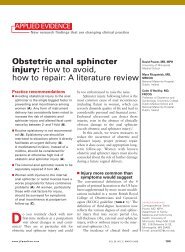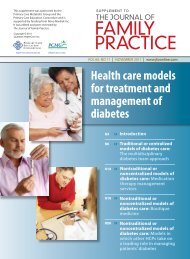Management of morbid obesity - The Journal of Family Practice
Management of morbid obesity - The Journal of Family Practice
Management of morbid obesity - The Journal of Family Practice
You also want an ePaper? Increase the reach of your titles
YUMPU automatically turns print PDFs into web optimized ePapers that Google loves.
niques, and psychotherapy<br />
(TABLE 2). A substantial<br />
body <strong>of</strong> literature is available<br />
for assessment <strong>of</strong> these<br />
options.<br />
Morbidly obese patients<br />
typically are more than 100<br />
lb (~45 kg) overweight.<br />
<strong>The</strong>refore, they need to be<br />
managed with treatments<br />
that have the potential to<br />
achieve substantial weight<br />
reductions and thereby correct<br />
<strong>obesity</strong>-related metabolic<br />
abnormalities. To date,<br />
all nonsurgical treatments<br />
for <strong>obesity</strong> have demonstrated<br />
maximum average<br />
weight-losses <strong>of</strong> 3 to 6 kg. 6,47<br />
In addition, noncompliance<br />
rates approximate 50%,<br />
and relapse rates after cessa-<br />
FIGURE 3<br />
Relative risk for any cancer<br />
tion <strong>of</strong> treatment approach nearly 100%. 6,47 Clearly, the<br />
primary care physician has few effective nonsurgical<br />
options for the <strong>morbid</strong>ly obese patient.<br />
Lifestyle changes<br />
Modification <strong>of</strong> diet (restriction <strong>of</strong> caloric intake) and<br />
aerobic exercise (increased energy consumption) form<br />
the mainstay <strong>of</strong> lifestyle changes. Dietary changes can<br />
decrease weight approximately 3 to 6 kg and adding<br />
exercise to a diet may be more effective than diet alone. 6<br />
No specific type <strong>of</strong> diet (eg, low-calorie vs low-carbohydrate)<br />
has been shown to be superior when caloric<br />
intakes <strong>of</strong> the diets are equivalent. 6,48 When used as<br />
monotherapy, exercise <strong>of</strong>fers minimal improvement, but<br />
it may prevent additional weight gain and improves cardiovascular<br />
fitness. 6<br />
As mentioned, the major concerns about using<br />
lifestyle changes in the treatment for the <strong>morbid</strong>ly obese<br />
patient are the relatively small impact on the patient’s<br />
total weight, the high rates <strong>of</strong> attrition, and the high rates<br />
<strong>of</strong> weight regain over time. 47<br />
Pharmacologic therapy<br />
Numerous medications have been used in the management<br />
<strong>of</strong> <strong>morbid</strong> <strong>obesity</strong>, but only two <strong>of</strong> them,<br />
2.0<br />
1.5<br />
1.0<br />
0.5<br />
0.0<br />
■ Men<br />
■ Women<br />
1.00 1.00 0.97<br />
BMI and cancer mortality<br />
1.08<br />
THE JOURNAL OF<br />
FAMILY<br />
PRACTICE<br />
18.5-24.9 25.0-29.9 30.0-34.9 35.0-39.9 ≥40<br />
Risk for death from all cancers increased as BMI increased in more than 900,000 US adults followed for<br />
16 years. Morbidly obese persons (BMI ≥40 kg/m 2 ) had the highest cancer death rates, with overall rates<br />
52% higher in men and 62% higher in women, compared with normal-weight adults. <strong>The</strong> most common<br />
weight-related cancer was liver cancer in men (combined risk ratio, 4.52 for BMI ≥35 kg/m 2 ) and cancer <strong>of</strong><br />
the corpus and uterus in women (combined risk ratio, 6.25 for BMI ≥35 kg/m 2 ). Overweight and <strong>obesity</strong><br />
were linked to 14% <strong>of</strong> deaths from cancer in men and 20% in women. Adapted from Calle et al. 39<br />
1.09<br />
BMI (kg/m 2 )<br />
1.23 1.20<br />
1.32<br />
1.52<br />
1.62<br />
sibutramine and orlistat, have been approved for longterm<br />
use. <strong>The</strong> US Food and Drug Administration includes<br />
the proviso that these 2 agents be administered in conjunction<br />
with a reduced-calorie diet.<br />
Sibutramine suppresses appetite through its inhibition<br />
<strong>of</strong> norepinephrine, serotonin, and dopamine reuptake.<br />
In clinical studies, patients taking sibutramine had<br />
a weight loss that was about 4 to 5 kg greater than that<br />
in placebo patients after 1 year <strong>of</strong> treatment. 28,29,47,49<br />
Even more significant, these studies excluded patients<br />
with BMIs greater than 40 kg/m 2 . Indeed, no studies <strong>of</strong><br />
the efficacy <strong>of</strong> sibutramine in <strong>morbid</strong>ly obese patients<br />
have been completed.<br />
Attrition rates in sibutramine trials have ranged<br />
from 17% to 47%. <strong>The</strong> most common side effects<br />
were dry mouth, anorexia, insomnia, constipation,<br />
and headache. 28,29,49 <strong>The</strong> agent also has been associated<br />
with small elevations <strong>of</strong> blood pressure and heart<br />
rate and should be administered with caution in<br />
patients with hypertension, particularly when it is<br />
uncontrolled or poorly controlled.<br />
Orlistat is a lipase inhibitor that prevents absorption<br />
<strong>of</strong> dietary fats in the stomach and small intestine.<br />
A Cochrane review <strong>of</strong> 11 orlistat trials indicated that<br />
patients taking orlistat had a 2.7-kg weight loss<br />
March 2005 Supplement to <strong>The</strong> <strong>Journal</strong> <strong>of</strong> <strong>Family</strong> <strong>Practice</strong> 7









